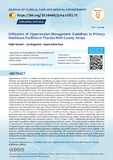Utilization of Hypertension Management Guidelines in Primary Healthcare Facilities in Tharaka Nithi County, Kenya

View/
Date
2024-02-08Author
KAMETI, ELIJAH
Mugambi, Joy
Opare-Addo, Paul
Metadata
Show full item recordAbstract
Hypertension (HTN) is a leading contributor to the global burden of non-communicable diseases (NCDs). The
effective management of hypertension constitutes an urgent need in developing countries, where its prevalence
is on the rise. Available data shows that Tharaka Nithi County is one of the regions with high hypertension burden
in the Kenya. Information on the adoption and implementation of HTN management guidelines is either limited or
completely lacking. We evaluated the level of utilization of HTN management guidelines among primary healthcare
facilities in Tharaka Nithi County. The study adopted a cross – sectional analytical design. Ninety-three healthcare
facilities were sampled using a multi-stage sampling technique and data collected using the modified World Health
Organization (WHO) Service Availability and Readiness Assessment (SARA) questionnaire. The data were analyzed
using the Statistical Package of Social Sciences (SPSS) version 27 for both descriptive statistics and inferential
statistics. Ethical approval was obtained from the Kabarak University Research Ethics Committee (KUREC) and data
collection permit from the National Commission of Science, Technology and Innovation (NACOSTI). Most of the
health facilities (96.8%) diagnose and manage HTN patients. Only a third (32.3%) of the facilities received a support
supervision visit more than two years ago. A third (34.4%) of the health facilities had a guideline utilization score
of two and a mean score of 2.11. The majority (64.5%, n=60) of health facilities reported unsatisfactory utilization
of guidelines in the management of hypertension. Healthcare facility category was found to have a significant
association with the availability of national guidelines (P = 0.001). ANOVA test showed a statistically significant
difference in the mean guideline score based on the type of health facility. Health centres had the highest score
while private medical clinics had the lowest score (F = 5.270, P value = 0.007). Statistically significant differences
were noted in guideline utilization among dispensaries and health centres. The study reveals a notable deficiency
in hypertension management guideline utilization (64.5% reporting suboptimal adherence), compounded by
infrequent support supervision visits (32.3% without visits in over two years). The significant association between
healthcare facility category and national guideline availability, along with variations in mean scores, highlights the
need for targeted interventions to address existing disparities. We recommend implementation of a systematic
support framework, ensuring regular support supervision visits for all health facilities, prioritizing those lacking
oversight for an extended period. Tailored interventions, particularly for private medical clinics with lower guideline
scores, are essential,
